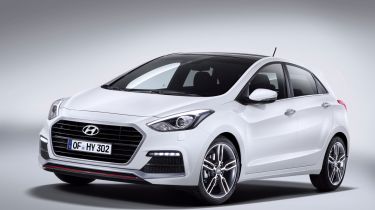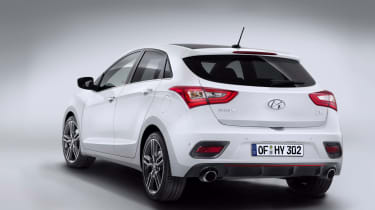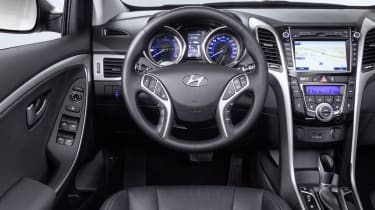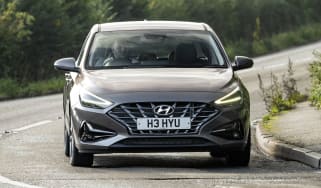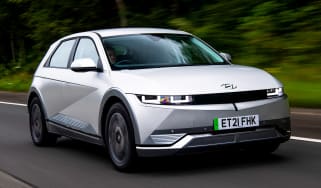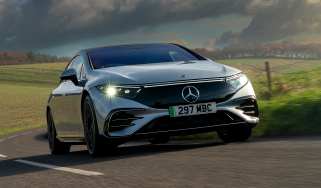New Turbo hot hatch and facelift for the Hyundai i30
Hyundai’s i30 Golf-rival gets a facelift, a new auto ‘box and a range-topping 183bhp i30 Turbo version
The Hyundai i30 has been given a mid-life facelift including revised styling, a seven-speed automatic gearbox, and all-new range-topping Turbo model. The new version will go on sale early in 2015.
The updated i30 features a hexagonal grille designed to accentuate the brand’s fresh family face, along with new alloy wheels and paint finishes. Design was rated the number one purchase reason for existing customers, so Hyundai has played it safe with the refreshed i30. Chief designer, Thomas Burkle said: “When designing the second-generation i30, we used strong, fluid lines to sculpt a car that exudes a sense of constant motion, even when stationary.”
However, the biggest changes are to the engine line-up. From next year, Hyundai will offer its five-door i30 hatchback with a turbocharged 1.6-litre engine – boasting 183bhp. Developed at the Nurburgring race circuit in Germany, the i30 Turbo is said to offer a focus on sporty driving dynamics and everyday usability.
The Turbo will come with a six-speed manual gearbox and specifically tuned suspension. It’ll do 0-62mph in eight seconds and hit a top speed of 136mph, returning around 39mpg in mixed motoring.
While those figures may not sound too exciting, Tony Whitehorn, President and CEO, Hyundai Motor UK, told us to expect a focus on engine technology over the next few years. Hyundai is planning changes to as much as 70 per cent of its engine range by 2020 – meaning improvements in performance, CO2 and mpg.
The i30 Turbo's biggest rival is arguably Kia’s more powerful Cee’d GT, but it’s fair to say the i30 Turbo will be considered a warm hatch – rather than a full-on Golf GTI rival – when it arrives in showrooms next year.
The news comes as Hyundai revealed its slow-selling Veloster will be axed from the UK line-up, just three years after it went on sale. The more conventional design and practical body of the i30 Turbo will be far better suited to the super-competitive hot hatch market. For now, the Turbo will be five-door only, despite the intention to offer it as a sportier three-door in foreign markets.
Tony Whitehorn said: "Three-door won’t be a big RHD market for us. This is not a sweetshop. As a manufacturer, you have to choose what will be the optimum seller."
That said, if the reaction to the three-door (shown at Hyundai's 'Product Momentum' conference in Frankfurt today) is positive, we wouldn't rule it out in the future.
Hyundai will hope to build on what it’s learnt from the Veloster’s failings, by offering even more kit on the i30 Turbo. Standard equipment includes 18-inch alloy wheels, LED daytime running lights and xenon headlamps. Twin exhausts and sporty red details complete the look. Prices will be confirmed closer to the car’s on sale date next year, but if the Cee’d GT is anything to go by, expect the i30 Turbo to come in at less than £20,000.
Other changes to the updated i30 range include improved safety, more economical engines and improved refinement. The new i30 comes fitted with six airbags, as well as a lane departure warning system and various electronic safety features. In addition, the new i30 range will also feature cruise control, a seven-inch touchscreen sat-nav, dual-zone climate control and a six-speaker audio system. Some of these features will be optional extras on basic trim levels.
The 1.4-litre petrol engine has been replaced by a new four-cylinder Kappa unit, resulting in lower fuel consumption and improved CO2 emissions. It’s 14kg lighter than before and will do 50mpg, emitting 129g/km of CO2. Elsewhere, the two 1.6-litre diesel and 1.6-litre petrol engine are now available with a seven-speed dual clutch automatic gearbox. The DCT replaces the old six-speed torque converter and allows drivers to choose between fully automatic driving or manual gear changes. Prices and exact specifications for the facelifted Hyundai i30 will be revealed nearer the car’s launch early next year.
Find a car with the experts

